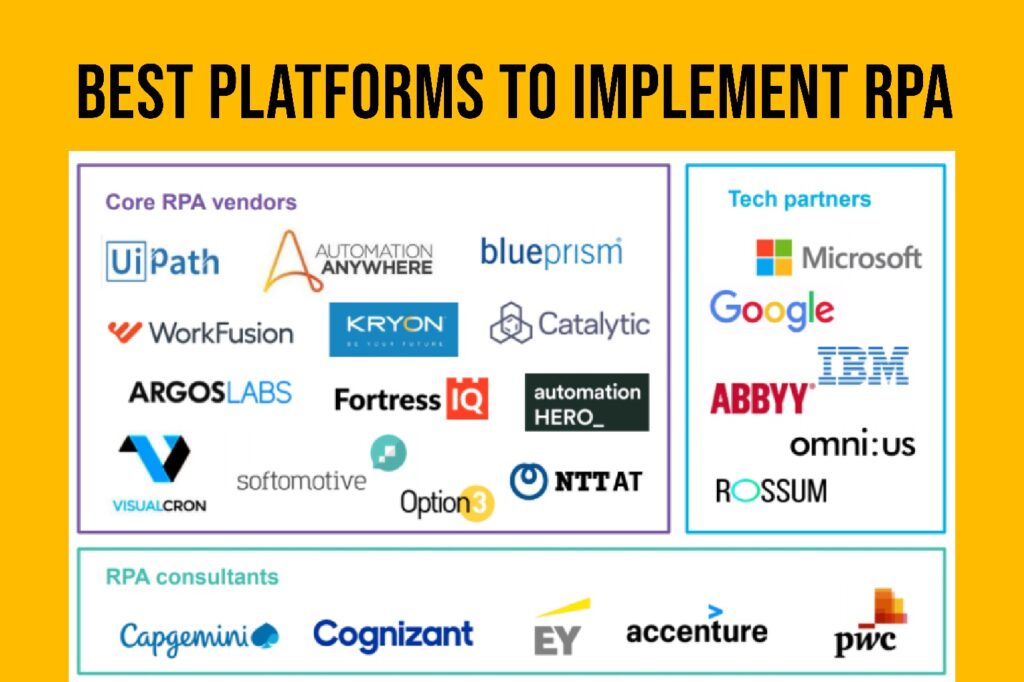RPA Implementation Guide:
Robotic process automation is a process of automating all tasks that humans do. It is implemented to enhance the efficiency of work and development. Implementation of RPA can be difficult for many organizations or businesses. RPA can be implemented in several ways. Still, three key methods are most commonly used: desktop automation, web application automation, and screen scraping. Here is a comprehensive guide on implementing RPA.
1) Desktop Automation:
This method uses the user interface (UI) to automate tasks on a local machine or virtual desktop. It automates tasks such as opening and closing applications, filling out forms, and extracting data.
2) Web Application Automation:
This method uses the UI to automate tasks in web-based applications. It generally automates tasks such as logging in, navigating through pages, and filling out forms.
3) Screen Scraping:
This method involves extracting data from a screen or series of screens. It usually automates tasks such as extracting data from a web page or PDF document.
These all have subsequent advantages and disadvantages and their specific needs and requirements. It depends on the best method for a particular organization.
Desktop Automation:
Advantages:
– Use to automate a wide range of tasks
– Does not require any special skills or knowledge to set up
– Use on a variety of local machines and virtual desktops
Disadvantages:
– Perform limited tasks on a local machine or virtual desktop
– May require the purchase of additional software to automate certain tasks
Web Application Automation:
Advantages:
– Automate a wide range of tasks in web-based applications
– Does not require any special skills or knowledge to set up
– Uses on a variety of web-based applications
Disadvantages:
– Limited to tasks that can be performed in web-based applications
– May require the purchase of additional software to automate certain tasks
Screen Scraping:
Advantages:
– Automate the extraction of data from a screen or series of screens
– Does not require any special skills or knowledge to set up
-Extract data from a variety of sources
Disadvantages:
– Limited to the extraction of data from screens
– May require the purchase of additional software to automate certain tasks
– Can be more time-consuming than other methods
Implementing RPA can provide a number of benefits to an organization, including increased efficiency, reduced costs, and improved accuracy.
RPA can be used to automate a wide variety of tasks, including:
– Opening and closing applications
– Filling out forms
– Extracting data
– Logging in
– Navigating through pages
Issues Faced While Implementation of RPA Software:
When it comes to RPA architecture, there are a few key issues that need to be considered to ensure a successful implementation. First and foremost, RPA software needs to be able to integrate with existing business systems and processes. This can often be challenging, as many RPA solutions are not designed to work with legacy systems. As a result, businesses must carefully consider their RPA options to ensure they can integrate the solution with their existing infrastructure.
Another key issue that needs to be considered is scalability. RPA solutions need to be able to scale up or down as business needs change. This is often a challenge, as many RPA solutions are not designed to be easily scalable. As a result, businesses need to carefully consider their RPA options to ensure that they will be able to scale the solution as needed.
Finally, RPA solutions need to be able to provide a high degree of automation. This is often a challenge, as many RPA solutions are not designed to provide a high degree of automation. As a result, businesses need to carefully consider their RPA options to ensure they can get the most out of the solution.
Best Platforms To Implement RPA:

When RPA is implemented correctly, it can be a game changer for a business, drastically improving efficiency and productivity while reducing costs. But as with any new technology, there is a learning curve associated with RPA. To get the most out of RPA, it’s important to have a clear understanding of the different types of RPA architectures and how they can be best applied to achieve your desired outcomes.
There are three main types of RPA architectures:
- Centralized RPA Architecture
- Decentralized RPA Architecture
- Hybrid RPA Architecture
Each architecture has its unique advantages and disadvantages that should be in consideration when determining which is best for your organization.
Read More: Designing the Best Architecture of An RPA Solution
Several RPA platforms are available in the market, each with its own set of features and capabilities. Here is a list of some of the best platforms that can be used to implement RPA:
- UiPath: UiPath is one of the most popular RPA platforms available today. It offers a wide range of features and is suitable for various RPA use cases. It also provides many integrations with other software applications.
- Blue Prism: Blue Prism is another popular RPA platform that offers robust capabilities for automating business processes. It provides features such as a drag-and-drop interface, reusable components, and more.
- Automation Anywhere: Automation Anywhere is an RPA platform that offers desktop and web-based solutions for automating business processes. It also provides several features, such as process mining, data visualization, and more.
4.WorkFusion: WorkFusion is an RPA platform that offers both on-premise and cloud-based solutions. It provides many features, such as process mining, data visualization, and more.
These are just a few of the many RPA platforms available. Each RPA platform has its own set of features and capabilities. Choose the RPA platform that best suits your needs and requirements.
Conclusion:
There is no one-size-fits-all when it comes to RPA platforms. Each RPA platform has its own set of features and capabilities. Choose the RPA platform that best suits your needs and requirements.
Read More: Top 10 real-world examples of RPA in different fields
